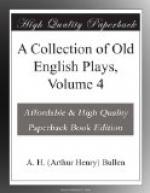Although not published until 1601, the Two Tragedies would seem from internal evidence to have been written some years earlier. The language has a bald, antiquated look, and the stage-directions are amusingly simple. I once entertained a theory (which I cannot bring myself to wholly discard) that Arden of Feversham, 1592, Warning for Fair Women, 1599, and Two Tragedies in One, 1601, are all by the same hand; that the Warning and Two Tragedies, though published later, were early essays by the author whose genius displayed its full power in Arden of Feversham. A reader who will take the trouble to read the three plays together will discover many points of similarity between them. Arden is far more powerful than the two other plays; but I venture to think that the superiority lies rather in single scenes and detached passages than in general dramatic treatment. The noble scene of the quarrel and reconciliation between Alice Arden and Mosbie is incomparably finer than any scene in the Warning or Two Tragedies; but I am not sure that Arden contains another scene which can be definitely pronounced to be beyond Yarington’s ability, though there are many scattered passages displaying such poetry as we find nowhere in the Two Tragedies. That Yarington could write vigorously is shown in the scene where Fallerio hires the two murderers (who remind us of Shagbag and Black Will in Arden) to murder his nephew; and again in the quarrel between these two ruffians. Allenso’s affection for his little cousin and solicitude at their parting are tenderly portrayed with homely touches of quiet pathos. The diction of the Two Tragedies is plain and unadorned. In reading Arden we sometimes feel that the simplicity of language has been deliberately adopted for artistic purposes; that the author held plenty of strength in reserve, and would not have been wanting if the argument had demanded a loftier style. In Yarington’s case we have no such feeling. He seems to be giving us the best that he had to give; and it must be confessed that he is intolerably flat at times. It is difficult to resist a smile when the compassionate Neighbour (in his shirt), discovering poor Thomas Winchester with the hammer sticking in his head, delivers himself after this fashion:—
“What cruell hand hath
done so foule a deede,
Thus to bemangle a distressed
youth
Without all pittie or a due
remorse!
See how the hammer sticketh
in his head
Wherewith this honest youth
is done to death!
Speak, honest Thomas,
if any speach remaine:
What cruell hand hath done
this villanie?”
Merry’s “last dying speech and confession” is as nasty as such things usually are.
In the introduction to Arden of Feversham I intend to return to the consideration of Yarington’s Two Tragedies.
Two Lamentable Tragedies.




